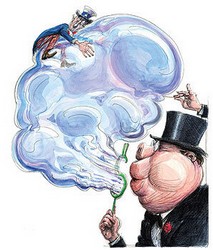 Fast-forward to today. It's early June in Washington, D.C. Barack Obama, a popular young politician whose leading private campaign donor was an investment bank called Goldman Sachs — its employees paid some $981,000 to his campaign — sits in the White House. Having seamlessly navigated the political minefield of the bailout era, Goldman is once again back to its old business, scouting out loopholes in a new government-created market with the aid of a new set of alumni occupying key government jobs.
Fast-forward to today. It's early June in Washington, D.C. Barack Obama, a popular young politician whose leading private campaign donor was an investment bank called Goldman Sachs — its employees paid some $981,000 to his campaign — sits in the White House. Having seamlessly navigated the political minefield of the bailout era, Goldman is once again back to its old business, scouting out loopholes in a new government-created market with the aid of a new set of alumni occupying key government jobs.Gone are Hank Paulson and Neel Kashkari; in their place are Treasury chief of staff Mark Patterson and CFTC chief Gary Gensler, both former Goldmanites. (Gensler was the firm's cohead of finance.) And instead of credit derivatives or oil futures or mortgage-backed CDOs, the new game in town, the next bubble, is in carbon credits — a booming trillion dollar market that barely even exists yet, but will if the Democratic Party that it gave $4,452,585 to in the last election manages to push into existence a groundbreaking new commodities bubble, disguised as an "environmental plan," called cap-and-trade.
The new carboncredit market is a virtual repeat of the commodities-market casino that's been kind to Goldman, except it has one delicious new wrinkle: If the plan goes forward as expected, the rise in prices will be government-mandated. Goldman won't even have to rig the game.
It will be rigged in advance.
Here's how it works: If the bill passes, there will be limits for coal plants, utilities, natural-gas distributors and numerous other industries on the amount of carbon emissions (a.k.a. greenhouse gases) they can produce per year. If the companies go over their allotment, they will be able to buy "allocations" or credits from other companies that have managed to produce fewer emissions. President Obama conservatively estimates that about $646 billion worth of carbon credits will be auctioned in the first seven years; one of his top economic aides speculates that the real number might be twice or even three times that amount.
The feature of this plan that has special appeal to speculators is that the "cap" on carbon will be continually lowered by the government, which means that carbon credits will become more and more scarce with each passing year. Which means that this is a brand new commodities market where the main commodity to be traded is guaranteed to rise in price over time. The volume of this new market will be upwards of a trillion dollars annually; for comparison's sake, the annual combined revenues of all electricity suppliers in the U.S. total $320 billion. Goldman wants this bill.
The bank owns a 10 percent stake in the Chicago Climate Exchange, where the carbon credits will be traded. Moreover, Goldman owns a minority stake in Blue Source LLC, a Utahbased firm that sells carbon credits of the type that will be in great demand if the bill passes. Nobel Prize winner Al Gore, who is intimately involved with the planning of cap-and-trade, started up a company called Generation Investment Management with three former bigwigs from Goldman Sachs Asset Management, David Blood, Mark Ferguson and Peter Harris. Their business? Investing in carbon offsets. There's also a $500 million Green Growth Fund set up by a Goldmanite to invest in greentech … the list goes on and on. Goldman is ahead of the headlines again, just waiting for someone to make it rain in the right spot. Will this market be bigger than the energyfutures market?
"Oh, it'll dwarf it," says a former staffer on the House energy committee.
Please read full by - Rolling Stone